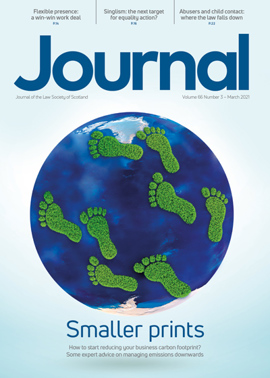Climate action: positive steps for progressive lawyers

I get a wave of panic and inertia when I think about climate change. I am not alone in that, and do you know what? It’s OK to experience that feeling. Global heating is the biggest challenge of our time, so it isn’t surprising that we feel overwhelmed. However, it is not OK to do nothing about it.
It is much more convenient to look to Government agencies, or just anyone else, to do something, but we all need to act to mitigate climate change.
We are all busy right now, whether supporting struggling clients through COVID, looking out for the mental health of our teams, friends, or family, or navigating home schooling.
It needs to be easy for people to make a positive change for the planet.
What can I offer? I worked as an environmental lawyer for many years before taking the leap into consultancy. My business made the transition to being carbon negative in 2019 (we have offset our emissions by a factor of two, at a cost of just over £2,100). We want to help others so we can all get carbon emissions down to zero quicker.
For us the long term plan had to be authentic to our business. With strong family ties to Argyll, we bought land and planted almost 30,000 native trees to create Lochgair Woodland. This will sequester 10,000 tonnes of CO2 over the next 100 years. (Read about our story here.)
We are sharing our experience and knowledge to make it easier for time strapped businesses to make practical changes. This article is a practical guide, designed to help others make the move to net zero carbon or beyond. I hope it helps.
What do lawyers bring to the table?
As professional advisers, lawyers have a role to play helping clients avoid costly pitfalls. Just like health and safety and cybersecurity, climate change is an important risk that must be addressed in procurement questionnaires and contracts.
Climate change risks include physical risks such as security, business interruption caused by extreme weather, and flooding resulting in supply chain failures or reduced value of business assets.
There are climate change liability lawsuits for greenhouse gas emissions, which I will not go into here; suffice to say, on a very basic level, there is a negative reputational risk for businesses that fail to act. Others have made their move (Google, Microsoft, ScottishPower Renewables). You do not want to be the last person at the party.
So, let’s get to work. First, look at your own business. (This advice will work equally well for clients; however, I suggest law firms will want to feel confident about their own position before advising others.)
Measure your carbon footprint
You need to know how much greenhouse gas you are emitting to understand your business impact on the planet (your carbon footprint). This will help you see where your emissions are coming from, and formulate the best plan for reducing them.
To get to grips with this, you need information on electricity and gas consumption, vehicle mileage, flights, and waste volumes, for example for the past year. All these are business costs that will be documented in your company finances. (Aside from understanding your emissions, it is a useful exercise that may help you identify more affordable, greener energy suppliers.) You will then need to find a carbon management consultant to guide your next steps.
You’ve measured your emissions; now manage them
Ideally, we want to be able to manage emissions down to zero. For most businesses, this is not possible. I believe technology and innovation will eventually enable this to happen, but for now, we must do what we can. It starts with drafting a carbon management plan.
A meaningful carbon management plan will set year-on-year targets to reduce emissions. This might be from energy efficiency in offices, reducing waste, and travel.
Starting with offices, many businesses are tied to leases and energy-inefficient buildings. Find out how you can make changes to save emissions and business costs by getting in touch with Zero Waste Scotland. They have loans available for energy efficiency upgrades. Landlords may be interested in getting involved, to increase the desirability of their properties.
Turning to vehicles, moving any fleet vehicles to electric is more affordable with funding available from Energy Savings Trust for charge point installation grants and secondhand electric vehicle loans.
Flights could be one of the fastest ways to make a dent on your carbon emissions. They are one of the worst emitters of pollution, so how about introducing a “trains over planes” policy? (And we all know how to use Teams and Zoom now.)
With energy use, try turning down your office heating by 1 degree – and your hot water thermostat while you’re at it. Small changes can make a big difference over time. And change your energy supplier to one that uses 100% renewable energy.
Tackling waste has been fun for us. We opted for a wormery to tackle some of the food waste on-site (thankfully our office has a balcony on the River Kelvin, so the worms remain an outdoor feature).
Emissions you cannot reduce (yet)
It’s now time to look at offsetting. This is only for emissions we can’t reduce. Offsetting without making meaningful reductions to your emissions is referred to as greenwashing: throwing money at the problem without making the tough behavioural changes.
Offsetting is going to look different for everyone. For us, offsetting had to have a distinctly Scottish flavour; it had to be tangible, nature based, and involve the land. Read about how we did it here.
You may be keen to act quickly and move on, safe in the knowledge you have done the right thing. Alternatively, you may want a tailored approach that shows your clients your company values, using the opportunity to unite your team behind a common, greener vision of the future. Workshopping this with your colleagues is an exciting opportunity for team collaboration. Ask them to vote for the offset projects close to their heart. It could be tree planting, or you might feel strongly about clean water supplies or renewable power projects in Africa.
This approach will raise awareness in your team about what you are doing, and perhaps encourage discussions on how to do more. It will certainly help attract new recruits (it has for us).
However you proceed, it is important to research offsetting schemes that are verified. This will give you confidence as to the security and longevity of your chosen projects. If you don’t know where to start, avoid recreating the wheel and have a look at our carbon management plan to get discussions going.
Once your carbon is managed, make sure you get a process in place, a “how to” that you can easily repeat annually. Oh, and don’t forget to sign up to the Race to Zero campaign and tell your team and clients all about your brilliant work.
Ready to do more?
This is for the more competitive among us! Once you have a plan for your business, you can go deeper and look at what your suppliers are doing. If you think about it, your true carbon footprint includes your supply (or value) chain as well.
You can use your purchasing power to advise suppliers that you will be preferencing suppliers based on their carbon awareness and whether they offset. This will need time to implement fairly, but communicating your intention will clearly signal your plans.
How to have a carbon conversation
We as lawyers are in a unique position as trusted advisers to bring about positive change. Whether as traditional advisers, in-house legal, seconded, trainees or board members, we bring an inherent understanding of business risk, and climate change is the biggest risk of our time.
Lawyers are brought in for our expertise and know-how in particular areas; our strategic advice is sought after and valued. As such it is absolutely appropriate for you to ask what your company or client is doing about climate change and how it is reducing its carbon footprint.
For newer lawyers, this might feel a bit bold; for more experienced lawyers it might feel out of place to voice a concern on a topic that is not your area of expertise. Fret not. Climate change is on everyone’s radar in one way or another and we are all learning. What will be awkward is if clients ask first and we don’t have the knowledge to talk authoritatively about it.
COP26 is coming, and all eyes will be on Scotland: investors, future clients, world leaders, decision-makers. It is key that law firms and their clients have a clear understanding of their own carbon story.
There may not be an obvious initial opportunity, but team meetings and boardroom agendas are the perfect place. Get carbon and sustainability on the agenda so an awareness of the risks and opportunities can start to percolate through daily thinking and business operations.
It might feel uncomfortable for some as the full picture of our emissions emerges, and it should! We have work to do, but then so does everyone. We can’t walk away.
Make your move!
Calculate your carbon. Actually, do it. Even on an individual level, just take that first step. Do not hyperfocus on micro details; getting it broadly right is better than it going in your “to do” pile. Try the WWF carbon calculator. (Others are available.)
I love the analogy of the climate crisis being like a relay race. If none of this has provided you with an impetus to make a positive carbon change, perhaps try thinking about the baton we are passing on to our kids. Extinction of television-worthy, rare and beautiful species is just one part of it. If the mental load of climate change is overwhelming for us, the enormity of the task will be beyond repair by the time our children are making the decisions. That is not acceptable for any of us. I for one want to feel confident we have faced the situation head on and done what we can.
Lawscot COP26 Conference | Lawyers and climate change: leaders or followers?
Our Lawscot COP26 Conference is fast approaching. Book your place now as we bring together lawyers from across the globe to discuss the role of the lawyer on environmental impact.
Perspectives
Features
Briefings
- Civil court: Nuts and bolts issues
- Corporate: The limits of reflective loss
- Intellectual property: rights in employee creations
- Agriculture: Allowing tenants to leave for value
- Family: Teaming up to Zoom in on marriage
- Data protection: EU transfers flow for a little longer
- Scottish Solicitors' Discipline Tribunal
- Property: Access by prescription: challenge of proof
- In-house: Moving in-house as an NQ
In practice
- New AML guidance: what you need to know
- Schools outreach: a virtual revolution
- The Word of Gold: The joy of cheques
- Wills and executries: learning the hard way
- OPG update
- The Eternal Optimist: No going back
- Handling police complaints: seeking fitness for purpose
- Profile: Christine O’Neill QC
- Ask Ash: Double demands







